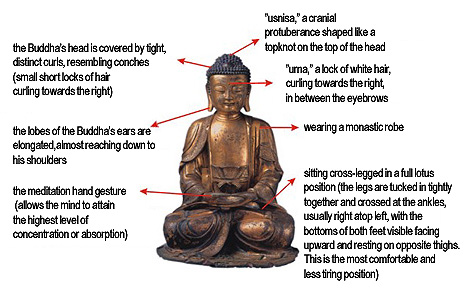| |
| ◎
The
Buddha Image│1│2│3│ |
|
◎
The Origin of the Buddha Image
Have you ever missed anyone before? After his
enlightenment, the Buddha went to the Trayastrimsa Heaven to teach the
Dharma to his mother. During the Buddha's absence from the human world,
King Udayana of Kausambi thought of the Buddha day and night. In order
to relieve himself of the longing that he had for the Buddha, the king
commissioned an artist to carve a five-foot tall figure of the Buddha
in sandalwood and this is the beginning of the first Buddha image.
◎The Appearances of the Buddha
Image
What is the difference between the appearance
of the Buddha and ordinary people? The Buddha has thirty-two distinguished
marks on his body that are remarkable and wondrous, such as the lock of
white hair between the eyebrows and the protuberance shaped like a topknot
on the crown of the head.
 |
◎The
Postures of the Buddha Image
What kind of a pose will you strike when you are about to have your
pictures taken? Similarly, what kind of posture do you think that the
Buddha will be depicted with in Buddhist art to convey a sense of unsurpassed
dignity?
(1)The Walking
Posture:When walking, the Buddha always looked straight ahead,
without losing his concentration. He would always take gentle steps forward,
like a mild breeze, without dragging his feet.
(2) The
Standing Posture:The Buddha would always stand straight up, facing
forward in a calm manner. While his body is perfectly proportioned and
symmetrical, his back is straight like the pine and the cypress.
(3)
The Sitting Posture:In sitting, the Buddha's body is always relaxed,
with utmost concentration of the mind. Although relaxed, the Buddha is
never restless, but steady like a big bell. Following are three types
of sitting posture:
(a) Full
Lotus Position: the legs are tucked in tightly together and crossed
at the ankles with the bottoms of both feet visible facing upward and
resting on opposite thighs. This posture is also known as the “Meditation
Position.”
(b) Half-Lotus
Position: the right leg rests squarely atop the left, or vice versa.
(c) Supporting
Position: the body sits upright on a seat, with head straight and
chest out. The legs are down naturally with feet resting squarely on the
ground.
(4)The Reclining Posture :When
would the Buddha be lying down? When the Buddha is resting or passing
into parinirvana, he is shown to be lying on his right side, with his
right hand supporting his head like a pillow and his left hand resting
flat atop his left leg. This serene position, also known as the “Parinirvana
Posture,” is symbolic of the Buddha's passing into nirvana.
| ---------------------
Top from left:
1. The Standing Posture、2. The Walking Posture
3. The Sitting Posture、4. The Reclining Posture
----------------------
middle from left:
1. The Walking Posture、2.
The Standing Posture 、3.
4. The Sitting Posture
----------------------
bottom from
left:
1 . The Sitting Posture、2. The Reclining Posture
|
|
|
|











